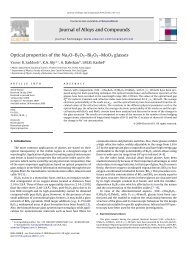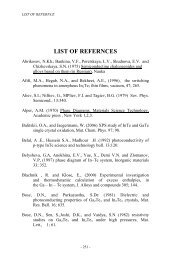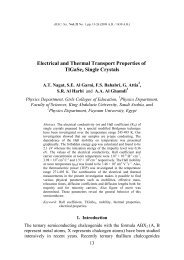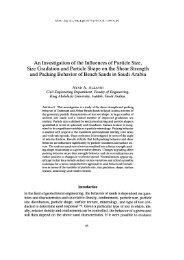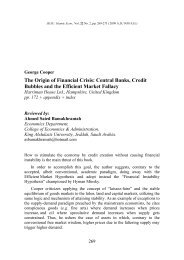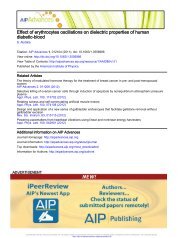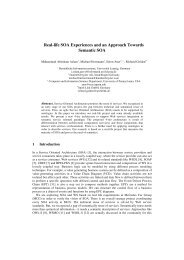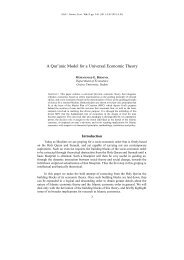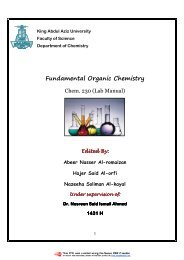Incidence and Pattern of Skin Cancer: Experience of
Incidence and Pattern of Skin Cancer: Experience of
Incidence and Pattern of Skin Cancer: Experience of
You also want an ePaper? Increase the reach of your titles
YUMPU automatically turns print PDFs into web optimized ePapers that Google loves.
<strong>Incidence</strong> J KAU: <strong>and</strong> <strong>Pattern</strong> Med. Sci., <strong>of</strong> <strong>Skin</strong> Vol. <strong>Cancer</strong>: 9, pp. 41-47 <strong>Experience</strong> (1421 <strong>of</strong> A.H. Two / 2001 Referral A.D.) Hospitals ...<br />
41<br />
<strong>Incidence</strong> <strong>and</strong> <strong>Pattern</strong> <strong>of</strong> <strong>Skin</strong> <strong>Cancer</strong>: <strong>Experience</strong> <strong>of</strong> Two Referral<br />
Hospitals in Jeddah, Saudi Arabia<br />
SAMEER K. ZIMMO, MD * , ALI A. RADDADI, MD ** ,<br />
SHAREEF ABDULLAH, MMBS ** , <strong>and</strong> OSAMA I. NASSIF, FRCPC ***<br />
*<br />
Department <strong>of</strong> Dermatology, *** Department <strong>of</strong> Pathology,<br />
Faculty <strong>of</strong> Medicine & Allied Sciences, King Abdulaziz University,<br />
<strong>and</strong> ** Department <strong>of</strong> Dermatology, King Khalid National Guard Hospital,<br />
Jeddah, Saudi Arabia<br />
ABSTRACT. This retrospective study describes the pattern <strong>of</strong> malignant skin tumors<br />
in 74 cases seen at King Abdulaziz University Hospital between 1984<br />
<strong>and</strong> 1996, <strong>and</strong> at King Khalid National Guard Hospital between 1994 <strong>and</strong><br />
1996. Among the 53 cases <strong>of</strong> known nationalities, 28 were Saudis <strong>and</strong> 25<br />
were non-Saudis. The male to female ratio <strong>of</strong> all cases was 1.7:1.0. The mean<br />
age was 53 years. Basal cell carcinoma was the most common cancer (35%),<br />
followed by Squamous cell carcinoma (20%), <strong>and</strong> Malignant Melanoma<br />
(10.6%). Basal cell carcinoma occurred on the head compared to Squamous<br />
cell carcinoma, which occurred on the head <strong>and</strong> extremities in equal frequency,<br />
while melanoma occurred mainly on the extremities. Cutaneous t-cell lymphoma<br />
occurred in 6.6% <strong>of</strong> the cases, while Kaposi sarcoma occurred in 5.4%<br />
<strong>of</strong> cases. Findings were compared with the available studies in Saudi Arabia<br />
<strong>and</strong> neighboring countries.<br />
Keywords: Basal cell carcinoma, Squamous cell carcinoma, Melanoma, Saudi<br />
Arabia.<br />
Introduction<br />
<strong>Skin</strong> cancer is common in the West. The incidence <strong>of</strong> skin cancer is highest in those<br />
geographic regions where light-skinned people are exposed to large amounts <strong>of</strong> sunlight<br />
compared to dark-skinned people [1] . It is uncommon to see skin cancers in the<br />
dermatology clinics in Saudi Arabia. A recent study from the Asir region described the<br />
Correspondence & reprint requests to: Dr. Sameer K. Zimmo, Department <strong>of</strong> Dermatology (Internal Medicine),<br />
P.O. Box 80215, Jeddah 21589, Saudi Arabia.<br />
Accepted for publication: 30 May 2001. Received: 1 June 1999.<br />
41
42<br />
S.K. Zimmo et al<br />
pattern <strong>of</strong> malignant skin tumors in that region [2] . Other studies from Saudi Arabia<br />
have described the patterns <strong>of</strong> malignant tumors in general, one from the Asir region,<br />
another one from the Eastern region, <strong>and</strong> a third from the Western region in mid 1970s,<br />
<strong>and</strong> the fourth from the Al Baha area [3-6] . We wanted to study the pattern <strong>of</strong> malignant<br />
skin tumors in two <strong>of</strong> the tertiary referral hospitals in Jeddah which are referral hospitals<br />
serving different socioeconomic <strong>and</strong> ethnic groups.<br />
Patients <strong>and</strong> Methods<br />
From 1984 to 1996 all cases <strong>of</strong> histologically confirmed skin cancer at King Abdulaziz<br />
University Hospital (KAUH) were collected. While it was possible to retrieve<br />
cases from King Khalid National Guard Hospital (KKNGH) in Jeddah, they were collected<br />
from 1992 to 1996. The two hospitals have 550 beds <strong>and</strong> serve a large portion<br />
<strong>of</strong> the patients in Jeddah. The patient’s characteristics <strong>and</strong> information were collected<br />
from their medical files.<br />
Results<br />
During the 13-year period, 40 cases <strong>of</strong> skin cancer were identified at KAUH, while<br />
34 cases were identified at KKNGH (Table 1). Among the 53 cases <strong>of</strong> known nationalities,<br />
28 were Saudis <strong>and</strong> 25 were non-Saudi, with the equal ratio <strong>of</strong> 1:1. The<br />
male to female ratio <strong>of</strong> all the cases was 1.7:1.0 (47 males, 27 females). The mean age<br />
was 53 years (2 months - 82 years).<br />
TABLE 1. Distribution <strong>of</strong> different types <strong>of</strong> skin cancer <strong>and</strong> patients’ characterisics <strong>and</strong> tumor sites.<br />
Histopathology No. <strong>of</strong> Cases Sex Mean Nationality Site<br />
M F Age Saudi<br />
Non-<br />
Saudi<br />
Head Trunk Extremities<br />
BCC 26(35)<br />
17<br />
9<br />
55.6<br />
7<br />
13<br />
22<br />
1<br />
-<br />
SCC<br />
15(20)<br />
12<br />
3<br />
41.0<br />
6<br />
2<br />
5<br />
1<br />
5<br />
MM<br />
8(10.6)<br />
2<br />
6<br />
60.0<br />
3<br />
3<br />
1<br />
2<br />
3<br />
CTCL<br />
5(6.6)<br />
4<br />
1<br />
41.2<br />
4<br />
1<br />
1<br />
5<br />
5<br />
BASOSCC<br />
3(4)<br />
2<br />
1<br />
58.0<br />
-<br />
-<br />
1<br />
-<br />
-<br />
KS<br />
4(5.4)<br />
4<br />
-<br />
65.0<br />
3<br />
1<br />
-<br />
-<br />
4<br />
OTHERS 11(14.9) 6 5 47.8 3 4 1 6 1<br />
BCC=Basal cell carcinoma; SCC=Squamous cell carcinoma; MM=Malignant melanoma;<br />
CTCL=Cutaneouss T cell lymphoma; BASOSCC=Baso-squamous cell carcinoma; KS-Kaposi sarcoma.
<strong>Incidence</strong> <strong>and</strong> <strong>Pattern</strong> <strong>of</strong> <strong>Skin</strong> <strong>Cancer</strong>: <strong>Experience</strong> <strong>of</strong> Two Referral Hospitals ...<br />
43<br />
Basal cell carcinoma (BCC) was the most common cancer (35%). Two young cases<br />
with BCC; a 16-year old non-Saudi patient with Xeroderma Pigmentosum, <strong>and</strong> a 31-<br />
year old Saudi albino male. Four patients had pigmented BCC, 2 Saudis <strong>and</strong> 2 non-<br />
Saudis. One patient had skin type 6 <strong>and</strong> another had skin type 5, while the rest <strong>of</strong> the<br />
patients had skin type 3 <strong>and</strong> 4. The most common site <strong>of</strong> BCC was the head in 84.6%<br />
<strong>of</strong> the cases.<br />
Squamous cell carcinoma was the second most common skin cancer in 20% <strong>of</strong> the<br />
patients, then malignant melanoma was found in 10.6% <strong>of</strong> the patients. Three cases<br />
(4%) were baso-squamous cell carcinoma, 1 on the face while the 2 others’ sites were<br />
not recorded.<br />
Cutaneous t-cell lymphoma was found in 5 cases (6.8%); Kaposi sarcoma in 4 cases,<br />
1 <strong>of</strong> them was a non-Saudi male with positive HIV, while the other 3 were elderly Saudi<br />
men with negative HIV. There was 1 case <strong>of</strong> leomyosarcoma <strong>and</strong> 1 case <strong>of</strong> dermat<strong>of</strong>ibrosarcoma<br />
protubrans. Other skin cancer cases (14.9%) were non-primary skin<br />
cancer victims (metastasis from breast carcinoma, thyroid carcinoma, <strong>and</strong> leukemia infiltrate<br />
<strong>and</strong> non-Hodgkin's lymphoma). Malignant appendgeal skin tumors were rare<br />
<strong>and</strong> were not included in this study.<br />
Discussion<br />
The number <strong>of</strong> cases <strong>of</strong> skin cancer in this study was low (total 74 cases), although,<br />
the cases were collected over 13 years at KAUH <strong>and</strong> over 4 years at KKNGH. It is unlikely<br />
that this low number to be secondary to under reporting, as all the surgical pathology<br />
materials <strong>and</strong> their results are recorded. So it is presumed a true reflection <strong>of</strong><br />
the cases we see in these hospitals.<br />
This was similar to the finding in a 500 bed Al-Ain teaching hospital. In the neighboring<br />
country <strong>of</strong> the United Arab Emirates, 52 cases were found over a 15-year period<br />
between 1981 <strong>and</strong> 1995 [7] .<br />
One hundred <strong>and</strong> thirty-seven cases over a 5-year period, between 1987 <strong>and</strong> 1991,<br />
were reported from the Asir region where cases <strong>of</strong> malignant skin tumors received at<br />
the Asir Central Hospital laboratory were examined. This laboratory is the only central<br />
pathology laboratory to receive all pathology specimens from different peripheral hospitals<br />
<strong>of</strong> the Ministry <strong>of</strong> Health in this region [2] .<br />
From the same hospital in an earlier study , 96 cases were found over a 3-year period<br />
between 1987 <strong>and</strong> 1989 [3] .<br />
In another study from the Eastern region <strong>of</strong> Saudi Arabia, 33 cases (18 Saudis <strong>and</strong> 15<br />
non-Saudis) were found over 2 years between 1987 <strong>and</strong> 1988 [4] . This was a population-based<br />
study where cases were collected from all over the Eastern region including
44<br />
S.K. Zimmo et al<br />
the Central Pathology Laboratory <strong>of</strong> the region.<br />
In 1979, Stirling et al reported 155 skin cancer cases collected over a 3-year period<br />
from the central laboratory, Bab Sharif General Hospital, Jeddah. This laboratory<br />
serves the Government hospitals <strong>and</strong> specialty clinics <strong>of</strong> the whole <strong>of</strong> the western region<br />
<strong>of</strong> Saudi Arabia including the urban population <strong>of</strong> Makkah, Madinah, Taif, <strong>and</strong><br />
Jeddah [5] .<br />
So it is clear that the numbers reported in these studies represent cases from the<br />
whole region hospitals <strong>and</strong> not from a single hospital. Table 2 compares the findings <strong>of</strong><br />
our study to those reported from Asir <strong>and</strong> Al Baha regions.<br />
TABLE 2. Comparison <strong>of</strong> our study with Asir <strong>and</strong> Al Baha study.<br />
BCC<br />
SCC<br />
MM<br />
This Study Asir Study Al Baha Study<br />
35%<br />
36.5%<br />
52.3%<br />
20%<br />
41.6%<br />
27.9%<br />
10.6%<br />
11.7%<br />
14.0%<br />
BCC=Basal cell carcinoma; SCC=Squanous cell carcinoma; MM=Malignant melanoma.<br />
In our study, BCC was the most common skin cancer; this is the same as found in Al<br />
Baha, while it was the second most common cancer in Asir [2,6] .<br />
The mean age <strong>of</strong> our patients was 55.6 years; the female to male ratio was 2:1. The<br />
head was the most common site. It was more in non-Saudis with the ratio <strong>of</strong> 2:1.<br />
BCC was the prevailing skin cancer in Qatar, 66 cases <strong>of</strong> BCC were diagnosed from<br />
1990 to 1994. Expatriates formed the highest proportion <strong>and</strong> <strong>of</strong> these, Europeans were<br />
predominant [8] .<br />
Squamous cell carcinoma was the second primary skin cancer, representing 20% <strong>of</strong><br />
the cases. This was the same as in the Al Baha study representing 27.9% <strong>of</strong> cases,<br />
while it was the most common skin tumor in the Abha study in 41.6% <strong>of</strong> cases where<br />
29.8% <strong>of</strong> these cases developed chronic non-neoplastic skin lesions, i.e., osteomyelitis<br />
skin sinuses, keloids, traumatic <strong>and</strong> burn scars. In this study, SCC was more common<br />
in males than in females (4:1), with the mean age <strong>of</strong> 41 years, which is lower than in<br />
BCC cases, <strong>and</strong> lesions were mainly on the head <strong>and</strong> extremities.<br />
SCC (73 cases) was also more common than BCC (58 cases) in the western region<br />
<strong>of</strong> Saudi Arabia. They reasoned this to the “Partial Immunity” <strong>of</strong> the Arabs to BCC<br />
that was remarked previously [5] . In this study, they found <strong>of</strong>ten in the case <strong>of</strong> SCC<br />
there was a long history <strong>of</strong> an ulcerated lesion, but whether this was a pre-existing benign<br />
ulcer was uncertain. So it seems that the increased number <strong>of</strong> SCC over BCC may<br />
be due to the large number <strong>of</strong> cases <strong>of</strong> secondary SCC, rather than primary SCC.
<strong>Incidence</strong> <strong>and</strong> <strong>Pattern</strong> <strong>of</strong> <strong>Skin</strong> <strong>Cancer</strong>: <strong>Experience</strong> <strong>of</strong> Two Referral Hospitals ...<br />
45<br />
Cutaneous t-cell lymphoma was found in only 5 cases, which we believe is underestimated<br />
as we expect to find more cases. Probably it is under-diagnosed histologically,<br />
as the early cases are difficult to diagnose <strong>and</strong> patients usually need serial skin<br />
biopsies to detect the changes in the histology. Stirling et al found malignant lymphoma,<br />
particularly abdominal lymph node disease that was the most common <strong>of</strong> the<br />
life-threatening malignancies in 1,000 cases. Only 2/128 lymphoma cases were mycosis<br />
fungoides [5] .<br />
Kaposi sarcoma was found in 3 elderly Saudi patients, none <strong>of</strong> them had HIV infection<br />
or was a renal transplant recipient, so it was <strong>of</strong> the sporadic type. Malignant<br />
melanoma was found in 8 cases (10.6%), with the male to female ratio <strong>of</strong> 1:3, with the<br />
mean age <strong>of</strong> 60 years, mainly on extremities. This was similar to the findings <strong>of</strong> the<br />
Asir <strong>and</strong> Al Baha studies [2,6] . In the western region study, 19 cases were diagnosed,<br />
but their site <strong>and</strong> patient characteristics were not mentioned. Generally melanoma is<br />
not a common cancer in Saudi Arabia [5] .<br />
As Saudi Arabia has the highest sun intensity in the world [9] , we therefore expect to<br />
see a much higher frequency <strong>of</strong> skin cancer than in other parts <strong>of</strong> the world, e.g., Western<br />
countries. The reason for this low incidence in Saudi Arabia may be due to the reduced<br />
risk factors, i.e., dark skin colour, the way Saudi men <strong>and</strong> women dress <strong>and</strong> the<br />
avoidance <strong>of</strong> outdoor activities when sun intensity is high.<br />
In the 1994 National <strong>Cancer</strong> Registry Report (the only one report to date), 210 cases<br />
<strong>of</strong> skin cancer among Saudis was reported for the whole kingdom. These cases accounted<br />
for 4.2% <strong>of</strong> all newly diagnosed cases. <strong>Skin</strong> cancer ranked 10 th for males <strong>and</strong><br />
8 th for females. The five regions with the highest incidence rates were Riyadh 1.85;<br />
Asir 1.85; Eastern region 1.87; Hail 1.67; <strong>and</strong> Western region 1.47 [10] .<br />
We are in great need <strong>of</strong> better documentation <strong>of</strong> cancer cases in the Kingdom, especially<br />
since the national tumor registry has already started.<br />
References<br />
[1]. Fleming ID, Barnawell, Burlison PE, Rankin JS. <strong>Skin</strong> cancer in black patients. <strong>Cancer</strong> 1975; 35(3):<br />
600-605.<br />
[2] Bahamdan K, Morad N. <strong>Pattern</strong> <strong>of</strong> malignant skin tumors in Asir region, Saudi Arabia. Ann Saudi<br />
Med 1993; 13(5): 402-406.<br />
[3] Khan AR, Hussain NK, Al Saigh A, Malatani T, Sheikha A. <strong>Pattern</strong> <strong>of</strong>f cancer at Asir central hospital,<br />
Abha, Saudi Arabia. Ann Saudi Med 1991 ;11(3): 285-288.<br />
[4] Al Taminii T, Ibrahim E, Ibrahim AW, Al Bar A, Assuhaimi S, Gabriel G, Mishriky A, Al Idrissi<br />
H, Al Sohaibani M, Al Sibai M. <strong>Cancer</strong> in the eastern region <strong>of</strong> Saudi Arabia: a population-based<br />
study (1987-1988). Ann Saudi Med 1997; 17(1): 53-65.<br />
[5] Stirling G, Khalil A, Nada G, Saad A, Raheem M. Malignant neoplasms in Saudi Arabia. <strong>Cancer</strong><br />
1979; 44: 1543-1548.<br />
[6] Willen R, Patterson B. <strong>Pattern</strong> <strong>of</strong> malignant tumors in King Fahad hospital, Al Baha, Saudi Arabia.
46<br />
S.K. Zimmo et al<br />
Saudi Med J 1989; 40: 498-502.<br />
[7] El Helal TAA, Bener A, Galadari I. <strong>Pattern</strong> <strong>of</strong> cancer in the United Arab Emirates refeerred to Al<br />
Ain Hospital. Ann Saudi Med 1997; 17(5): 506-509.<br />
[8] Mahmoud SF, Azadeh B. Basal cell carcinoma in Qatar. Int J Dermatol 1996: 35: 704-706.<br />
[9] Sayigh A, Sebai Z, Halleem A. Preliminary study <strong>of</strong> the solar radiation effect on skin cancer. Proceedings<br />
<strong>of</strong> the first conference on biological aspects <strong>of</strong> Saudi Arabia, Riyadh, University <strong>of</strong> Riyadh<br />
1977.<br />
[10] Al Hamdan N, Michels-Harper D, Al Zahrani A, Bazarbashi S , Koriech O. 1994 Annual Report<br />
National <strong>Cancer</strong> Registry 1996: 31-32.
<strong>Incidence</strong> <strong>and</strong> <strong>Pattern</strong> <strong>of</strong> <strong>Skin</strong> <strong>Cancer</strong>: <strong>Experience</strong> <strong>of</strong> Two Referral Hospitals ...<br />
47<br />
s 5M« …d :UNËb W Ë bK'« «—Ë√ j/<br />
WœuF« WOdF« WJKL*U …b WMb wUA<br />
***n!U WU√ Ë , ** tÒK«bF« nd , ** Íœ«œd« wK , * u“ dC dOL<br />
, WOD« ÂuKF«Ë VD« WOKJ ÷« d_« rK*** Ë WMU« ÷«d_« r*<br />
, WMU« ÷«d_« r** Ë eeF«b pK*« WFU<br />
, wMu« ”dK bU pK*« vHA w WbK'« ÷«d_« WF<br />
WœuF« WOdF« WJKL*« − …b‡‡‡<br />
WU ∑¥ w W?OM'« bK'« «—Ë√ j/ W?«—b« Ác nB ÆhK?*«<br />
ÂU v≈ ±π∏¥ ÂU? s eeF«b? pK*« WF?U vHA?? w bu<br />
v≈ ±ππ¥ ÂU s wMu« ”dK bU pK*« v?HA wË ,±ππ∂<br />
≤∏ ,U?NU?O?M W?Ëd?F*« WU? Êu??L?Ë Wö?« sL?{ ÊU?Ë ,±ππ∂<br />
ÊU Ʊ:±[∑ ÀUû? —uc« W? XUË ,5œu?F d?O ≤µË ÎUœu?F<br />
Ud??√ Uö?)« Íb?U?I« Í—U?NE« —u« ÊU?Ë ,WM µ≥ d?L?F« ju??<br />
d?√ u ”√d« Ê√ bË Æ%≤∞ W?M wö*« —u« r %≥µ W?M ÎUu?O<br />
w« WO?Hd(« Uö?)« ÊUd W—UI? WbUI« Uö?)« —u WUF≈ l«u*«<br />
wö*« —u« Àb? U?LMO W?ËU?? V?M ·«d_«Ë ”√d« w b?Ë<br />
¡U??C??O???« Uö??)« Â—Ë Àb?? U???L?? Æ ôU??(« VK√ w? ·«d_« w<br />
Í“uU??? —ËË , ôU??(« s %∂[∂ w b?K'« `D vK? ÍËU??H??L???OK«<br />
ZzU?M W?«—b« Ác ZzU? X—u? bË Æ ôU?(« s %µ[¥ w YO??)«<br />
Æ…—ËU:« ‰Ëb«Ë WJKL*« v WKUL*« U«—b«




